The Microorganisms gallery offers 177 images of microbiology and several types of microorganisms. Microorganisms, also known as microbes, are organisms that are microscopic, and are usually too small to be seen by the naked human eye.

Globigerina
"Globigerina bulloides. GLOBIGERINIDAE. A family of chiefly pelagic foraminiferous rhizopods, with the…

Globigerina
"Globigerina bulloides. GLOBIGERINIDAE. A family of chiefly pelagic foraminiferous rhizopods, with the…
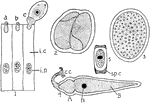
Gregarina
"Life history of Gregarina. 1. Young forms (a, b, c) emerging from intestinal cells (i.c.); i.n., nucleus…

Gregarina
"Gregarina, contents divided into pseudo-navicellae. GREGARINIDAE. A family or other major group of…

Gregarina
"Gregarina, contents divided into pseudo-navicellae. GREGARINIDAE. A family or other major group of…
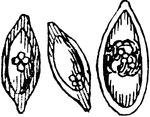
Gregarina
"Gregarina, free pseudo-navicellae. GREGARINIDAE. A family or other major group of endoplastic protozoans,…

Gregarina Encysted
"Gregarina of Earthworm, encysted. GREGARINIDAE. A family or other major group of endoplastic protozoans,…
Gregarina of Earthworm
"Gregarina of Earthworm. GREGARINIDAE. A family or other major group of endoplastic protozoans, having…

Amoebiform Gregarina
"Gregarina, their free amoebiform contents. GREGARINIDAE. A family or other major group of endoplastic…

Grovia Oviformis
Grovia Oviformis is a type of Foraminifera (a class of unicellular animal/protozoa). They are almost…

Bacteria Growth
"Showing the Effect of Variations in Temperature on Bacteria Growth. a, a single bacterium; b, its progeny…

Haliomma Hexacanthum
The body is enclosed in a glassy shell composed of flint. The shell is perforated by numerous holes…

Haliphysena Tumanvitzii
Haliphysena Tumanvitzii; living specimen showing the wineglass-shaped shell built up of sand-grains…

Hypothalline
"Hypothalline condition of Lecanora cinera, showing the origin of the first Cortical Gonidiogenous Cellules."…

Young Imperforata
An illustration of a young imperforata with shell dissolved and protoplasm so as to show the seven nuclei.
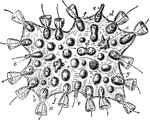
Infusorian
"A colonial flagellate Infusorian--Proterospongia haeckelii. There are about 40 flagellate individuals.…

Kondylostoma Patens
Related to the Paramecians. These are remarkable for their size and voracity; they sometimes attain…
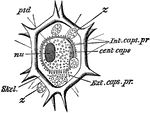
L. Annularis
"Liteocircus annularis. cent. caps, central capsule; ext. caps. pr, extra-capsular protoplasm; int.…
Lancelet
Diagram of a lancelet. The mouth is surrounded by a circle of tentacles; below the notochord is a row…
Lancelet
"Lateral view of Amphioxus. The notochord runs from tip to tip. t., Tentacular cirri; G., reproductive…
Lancelet
"Diagram of the anatomy of Amphioxus, drawn as a semi-transparent object. a, anus; a.p., atrial pore;…

Lancelet
"Amphioxus lanceolatus. A, ventral; B, side view of the entire animal. an, anus; atrp, atriopore; cd.…
Lancelet
Lancelet fish (Branchiostoma) is sometimes called amphioxus, the type of the class Leptocardii, is a…

Lancelet Section
"Amphioxus lanceolatus. A, transverse section of the pharyngeal region. a, dorsal aorta; b, atrium;…

Lancelet Stages
"Early stages in the development of Amphioxus. 1. Ovum with germinal vesicle; 2. four-cell stage; 3.…

Section of a lancelet
"Section of Ampioxus, fr, fin ray; ct, connective tissue; nc, notochord, ; snc, supraneural…

Side view of lancelet
"Side view of Amphioxus: fs, fin supports; nc, notochord; ot, oral tentacles."—Finley,…

Micrococci
"Characteristic groups of Micrococci. Micrococcus prodigiosus." — The Encyclopedia Britannica,…

Micrococci
"Characteristic groups of Micrococci. Micrococcus vaccinae." — The Encyclopedia Britannica, 1910

Micrococci
"Characteristic groups of Micrococci. Zoogloea stage of a Micrococcus, forming a close membrane on infusion."…

Types of Microorganisms
Types of microorganisms. Labels: a, micrococci arranged singly; in twos, diplococci- if all the micrococci…

Mitotic Division
"Indirect or mitotic division; A, resting mother nucleus; B, coil stage, with the centrosomes separating;…

Monas Lens
"The Monads are infusorial animalcules which make an early appearance in vegetable infusions. They have…
Monocystis
"Life history of Monocystis. 1. Young Gregarine lying within a sperm mother cell of earthworm. 2. Association…

Myconostoc
"Colonies of Myconostoc enveoped in diffluent matrix." — The Encyclopedia Britannica, 1910

Myconostoc
"Colonies of Myconostoc enveoped in diffluent matrix." — The Encyclopedia Britannica, 1910

Myconostoc
"Colonies of Myconostoc enveoped in diffluent matrix." — The Encyclopedia Britannica, 1910

Noctiluca Miliaris
"Flagellum of Noctiluca miliaris (highly magnified). s, transversely striated substance; b, base of…

Nodosaria
"A compound foraminiferan, Nodosaria. a, aperture of shell; f, food particles captured by the strands…

Nummulina Perforta
One group will take the spherical form and produce a shell in the shape of the nautilus. In this case,…

Nummulites Cummingii
Grovia oviformis is a type of Foraminifera (a class of unicellular animal/protozoa). They are almost…

Operculina
One group will take the spherical form and produce a shell in the shape of the nautilus. In this case,…

Organic Life, Collage of
A collage of different types of organic life including deer in a forest, farmers harvesting wheat, and…

Paramecium
"Paramecium in optical section. A, anterior end; c, tilia; e.d., ectosarc; e.n., endosarc; f.v., food…

Paramecium
"Paramoecium. ad. Adult form, showing cilia, "mouth," contractile vacuoles, etc. div. Transverse division.…

Paramecium Aurelia and its Parasites
In this image, (a) represents the parasites in the various stages of development, and (b), the larger…

Paramecium Bursaria (Pritchard)
"Paramecium Bursaria is the only species of Paramecium that forms symbiotic relationships with algae,…

Paramecium Division
"Paramecium. I, transverse fission; 2-5, stages in conjugation. The meganucleus gradually disintegrates…

Paramoecium Caudatum
"Paramoecium caudatum. A, the living animal from the ventral aspect; B, the same in optical section:…

Plumatella
"Their shells are usually of a leathery texture, nearly transparent, and usually spring from a root-stalk…
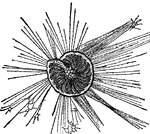
Polystomella Strigillata
Grovia Oviformis is a type of Foraminifera (a class of unicellular animal/protozoa). They are almost…

Propagation of an Infusorian by Spontaneous Division
"The singular phenomenon of spontaneous division may be witnessed by any one having patience to examine…

Protoplasm
The circulation of protoplasm (p) in a cell of the stamen-hair of Tradescania. In the channels the granules…

Protozoans
"Their bodies consist either of aa simple elementary cell, with its contents, or of an aggregation of…



